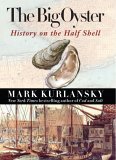Graham Reid | | 3 min read

One of the conspicuous growth areas in non-fiction has been in the genre of what we might call single-issue histories where a writer takes a seemingly mundane or commonplace subject -- be it tulips in Amsterdam, the humble potato or ubiquitous chocolate -- and expand a history around it.
The acknowledged master of this genre, and the most persistent and assiduous in his research, is New York writer and gourmet Mark Kurlansky whose opening gambit in the style was his remarkable book about the seemingly unpromising subject of cod, then an equally engrossing history of salt, and now -- after the digression into exploring the pivotal year of 1968 -- a book about oysters.
As with his other single-issue histories, the subject is nominal and the story becomes one in which empires and economies rise and fall, lives of ordinary and extraordinary people are essayed, and by the end it seems as if the only true subject ever worth exploring has been this previously untold one.
Although Kurlansky’s The Big Oyster now seems to be subtitled “History of the Half Shell”, early uncorrected proof copies came with a more apposite subtitle -- “New York and the World: A Molluscular History” -- for in these 300 tightly written pages where information, amusements and unexpected facts stack every paragraph the subject is no less than a history of New York itself, through that city’s obsession with, and culinary dependence on, oysters.
In a chronological account of the growth of New York from its earliest Native American residents -- among them the Lenape who it is believed ate around 250 oysters a day --to the Dutch settlers for whom the mollusc was already a staple, New York grew on the back of an abundance of oysters.
When the Dutch arrived New York’s harbours contained half the world’s oysters, and they weren’t small: middens show shells them averaging between 20 and 25 centimetres and even when Europeans arrived they were still at least 15cm long (which drew British novelist William Makepeace Thackeray to observe it was like eating a baby).
Oysters were so numerous in New York’s harbours they provided cheap food, and the sophisticated chefs and working class oyster bars of the town found dozens of ways to serve them: picked, baked, roasted, fried, in pies and stews, as a stuffing for chicken dishes, as sauces, garnishes . . .
Recipes called for pints of oysters and Eliza Leslie’s mid 19th century cookbook has some which typically start, “Take one hundred and fifty fine large oysters . . .”
Along the way Kurlansky includes numerous old recipes but also offers more bite-sized morsels of information; the last wolf on Manhattan was killed in 1686; how contemporary landmarks originally got their names; that in 1770 there were reportedly 500 prostitutes working in the city of some 21,000 people and they mostly plied their trade in oyster bars; and he notes the influence of Dutch on the language of New Yorkers.
But his real story of that of the growth of New York from a few buildings on a grassy island to the vibrant and crowded city if is today.
In an account familiar in our own history he writes of the misunderstanding between indigenous peoples and settlers over land ownership and debunks, or at least clarifies, the myth of Manhattan being sold for “beads and trinkets” worth about $24.
For those who have been to New York it is fascinating to read of Harlem being a village some three miles away, of the Bronx being farmlands, the Bowery [which is now in Downtown] being a suburb north of the city, and of generations of settlers dumping their rubbish over the wall (as in Wall Street) which the Dutch East India Company built in 1653 to protect settlers in New Amsterdam from the British.
The latter act was the beginning of the polluting of streams and canals which eventually found form in the industrialisation of the harbour side and the consequential contamination of the oyster beds.
In 1927 the last of the city’s once numerous and oyster beds was closed.
There are still oyster bars in the city, and new ones sometimes open. However they are not serving local oysters.
Kurlansky’s project -- sometimes too wedded to a discussion of oysters at the expense of further exploration the rich history he is unearthing -- reaches a conclusion which seems inevitable and wearily familiar.
Gluttony and greed, and a careless disregard for the consequences of rapacious appetites and pollution, have destroyed what was once a cornerstone of life in the New World.
And the result? Well, some might say it was New York as we see it today, a city as we now know -- thanks to Kurlansky -- which largely survived, grew fat on, and profited from an animal as ugly, and some would say as unpalatable, as the oyster.







post a comment